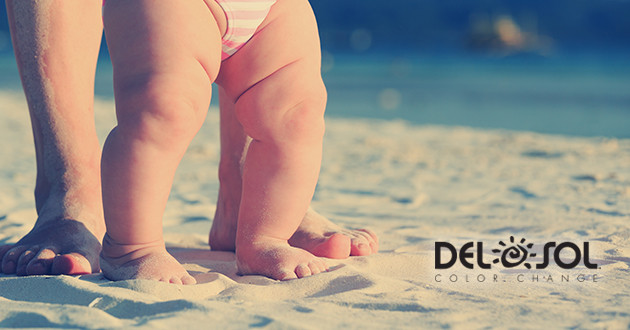Most parents already know the importance of making sure their kids wear sunscreen when they play outside, but did you know certain children’s sunscreens might be as dangerous as the sun damage they’re designed to prevent? Here’s what you need to know to protect your kids this summer.
1. Children’s skin can burn in less than 15 minutes
The sensitive skin of children burns more quickly than that of adults—even in as little as 15 minutes. Sometimes burns show up right away, but it may take up to 12 hours to fully appear. “If your child’s skin looks ‘a little pink today,” says WebMD, “it may be burned tomorrow morning. To prevent further burning, get your child out of the sun.”
If you don’t reapply sunscreen often enough or if your child plays in the water with sunscreen that isn’t water resistant, they’ll burn before you have a chance to do anything about it. Sunscreen isn’t foolproof, and that’s why WebMD doctors recommend wearing wide-brimmed hats, sunglasses and dark-colored clothing with a close weave in addition to sunscreen. They also warn against spending a lot of time outside between 10 a.m. and 4 p.m. when UV exposure is at its highest.
2. Some kids’ sunscreens contain hormone-disrupting chemicals
Certain sunscreens contain synthetic chemicals that can cause skin irritation and other adverse reactions because they’re absorbed deep into the skin. According to Women’s Health Magazine, certain ingredients in sunscreen “can generate cell-damaging free radicals when exposed to the sun.”
When finding sunscreen for your kids, watch out for sunscreens that include oxybenzone and octinoxate. According to the Environmental Working Group, “Oxybenzone, a hormone-disrupting chemical, is in 37 percent of kids’ sunscreens versus 56 percent of other sunscreens.”
3. Spray sunscreens could be toxic when inhaled
Spray-on sunscreen is incredibly convenient, especially when tasked with lotioning up a wriggly toddler. However, Consumer Reports warns of the possible damages when children inhale sunscreen and the FDA is currently conducting an investigation to determine whether they are safe for use on children. Consumer Reports suggests you not use spray-on sunscreens on children unless you have no other alternative available. Experts also warn spray sunscreens may not provide sufficient coverage to protect against the sun.
4. Sunscreens could inhibit vitamin D production
Vitamin D, which is synthesized from a chemical in your skin when exposed to sunlight, is used to strengthen bones and can prevent certain types of cancer. However, according to Harvard Medical School, excessive sunscreen use can lower vitamin D levels and negatively affect good bone health. Vitamin D production requires UVB, which is blocked by sunscreen, especially if it has a high SPF. Your sun needs healthy levels of sun. Be sure to monitor your time in the sun and avoid excessive application of sunscreen.
5. Not all sunscreen protects you from UV light
If you want to make sure your kids’ sunscreen is offering them full protection the sun, look for bottles that offer “broad spectrum” protection. Your skin needs protection from UVA and UVB rays, but a sunscreen’s sun protection factor (SPF) refers only to its ability to block UVB rays, which are primarily responsible for sunburn. UVA radiation, on the other hand, leads to premature skin aging and damage.
6. SPF 100 is no more effective than SPF 50
No matter how big the number 100 is on a sunscreen’s packaging, it doesn’t mean it offers any better protection than kids’ sunscreens that offer SPF 50+. According to SkinCancer.org, “Above SPF 50, the increase in UVB protection is minimal…Individuals applying high-SPF sunscreens may not burn (UVB is the chief cause of sunburn), but without UVA-screening ingredients they can still receive large amounts of skin-damaging radiation.” Provide additional protection to your skin by wearing extra clothing, seeking shade and reapplying sunscreen as often as necessary.
7. Some adult and kid sunscreens are identical
Unfortunately, some sunscreens marketed for kids are no different from adult sunscreens. In fact, EWG notes, “Sixteen brands included in the Sunscreen Safety Guide list exactly the same ingredients in their children’s products as in their products for general use.” You can check whether a sunscreen is truly formulated differently from the adult version by comparing the percentages of active ingredients.
EverydayFamily.com points out however that it is important for kids to use sunscreen made for children because, “baby sunscreen uses titanium dioxide or zinc oxide to form a physical barrier against the sun’s rays; these ingredients are not absorbed into the skin and are better for babies.” Although some parents avoid putting sunscreen on babies at all until they’re 6 months old, choosing to use clothing, hats and sunshades as sun protection instead.
Your kids can have fun in the sun this summer and still be protected from sunburn and skin damage. Check out DelSol’s line of fun, color-changing summertime clothing and accessories to keep your kids safe and having fun in the sun this summer. When you see the Del Sol products change color in the sun, and the color intensifies, it’s a good indicator that the UV index is high, and you should probably apply or reapply sunscreen.

